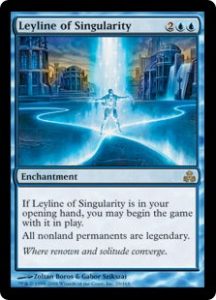This week’s Uncharted Realms takes us back to Zendikar after weeks of anticipation. While Jace and Gideon attempt to enlist allies to Zendikar’s cause abroad, Nissa refuses to leave the plane of her birth, fighting with her summoned elemental ally Ashaya against the otherworldly Eldrazi even as they reduce her world to desiccated wasteland. With victory seemingly impossible, Ashaya finally reveals to Nissa her capacity to draw upon the power of the plane’s leylines, and she summons a massive army of elementals from the soil and natural life of her home, leading her newfound forces against the Eldrazi titans.
The Fastest Way Between Two Points
While it’s not explicitly clear that Nissa has cracked the “riddle of the leylines” that holds the key to Zendikar’s salvation, it certainly seems like she has tapped into a mystical current of magical energy, a conduit which connects her to her plane as a branch to a tree. Ashaya’s prompting awakens in the elven Planeswalker an instinctual understanding of the leylines of Zendikar, allowing her to access their power to crush the invaders of her plane. It may be that these leylines, as rumored, have the power to repulse the Eldrazi and save Zendikar in the block to come.

The first leylines in Magic’s Multiverse were on Ravnica, where they hearkened to the plane’s pre-urban history and magic (not unlike their depiction on Earth!).
It is a pity, given their importance on Zendikar, that the actual history of leylines on Earth is either so ancient as to be completely hidden from the historical record, or modern enough to be a New Age fad.
The first recorded use of the term leylines comes from 1922 rather than some ancient age, as a theory of Neolithic settlement proposed by a British archaeologist. “Presume a primitive people,” wrote Alfred Watkins in his work Early British Trackways, “with few or no enclosures, wanting a few necessities (as salt, flint flakes, and, later on, metals) only to be had from a distance. The shortest way to such a distant point was a straight line.”
If not for later mystical interest in British history, it is likely that the leylines would be consigned to obscurity as a niche term in archaeology.
Without the hedges and roads and furrows of later expanded agriculture, Watkins postulated, these ancient peoples used high vantage points to plot direct lines of trade and travel between points of ceremonial or commercial interest in the prehistoric British landscape. These ancient pathways were also presumed to have some symbolic functions as well, but secondary to their purpose as trade routes. Mapping out the ruins of prehistoric construction, Watkins theorized that a number of ancient settlements fell along these “leylines” given their geometric pattern in relation to one another, and – importantly for later fans – these patterns remained a part of the British landscape into the modern day.
If not for later mystical interest in British history, it is likely that the leylines would be consigned to obscurity as a niche term in archaeology.
The Architecture of Harmonic Convergence
In 1969, English author John Michell was convinced that the world was entering a new age. “Despite the warnings of astrologers and students of sacred history,” begins his work The View Over Atlantis, “many find themselves unprepared for the changes that inevitably occur as the spring point enters Aquarius.” Based upon increased observation of supernatural phenomena like UFOs, and based upon C.G. Jung’s theory of archetypal symbolism, Michell postulated that the world was at the brink of an enormous discovery which would reshape belief, science, and understanding.
In Atlantis, Michell reintroduced Watkins’ work on prehistoric leylines, but combined this archeological theory with a great deal of popular cosmology including both numerology and feng shui. Rather than mere routes of commerce and ceremony, Michell suggested instead that the British leylines were ancient alignments of landmasses and sacred architecture which corresponded to mystical energies. Harmonizing with this untapped source of cosmic power would mark the end of the age of traditional authority and state power, and usher in a new era of human potential.
Michell’s work became an instant hit with counter-cultural groups of the 60’s, 70’s, and 80’s, all of whom had no love lost for traditional structures of authority and flocked to the sleepy villages of rural England to trace these ancient routes of power. The author himself became a celebrity academic, more or less shunned by other archaeological scholars, but beloved by young adherents and mystics (as well as the Rolling Stones).
Michell suggested that the British leylines were ancient alignments of landmasses and sacred architecture which corresponded to mystical energies.
In the end, on Zendikar as on Earth, there is no clear proof as to the purpose, power, or even existence of leylines as an archeological or mystical construct. If ancient peoples in England and elsewhere built along geometrically significant lines for purposes of rapid transit or sacred harmony, they left no written record to demonstrate the fact. A common critique of both Watkins’ and especially Michell’s work is that the existence of plausible patterns between prehistoric sites does not demonstrate the proof of a guiding theory behind their construction. Skeptics point out that correlating patterns exist between any number of mundane structures (including, for instance, Woolworth chain stores, which form triangles across the cities of Great Britain), proving only humanity’s capacity to find patterns in chaos rather than some overarching sacred geometry.
Nevertheless, Michell’s work continues to inspire mystical scholarship of ancient architecture and archaeology, used by schools of thought that postulate aid from forces as diverse as natural spirits or extraterrestrials.
The planeswalker Jace and archaeologists here on Earth share a common and noble desire to get to the bottom of the mystery of the leylines for the good of their respective worlds. While on Zendikar, they might contain the secret to defeating the Eldrazi, on Earth their study (and possible debunking) holds the key to undoing the History Channel’s programming dedicated to ancient aliens.
Curtis Wiemann keeps forgetting to add a bio to these articles, but welcomes your feedback in the comments!




